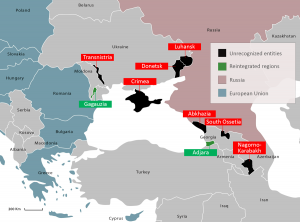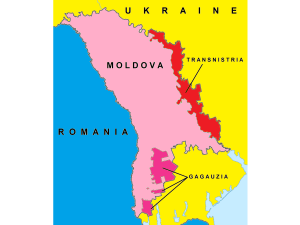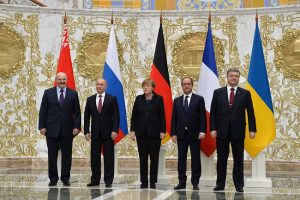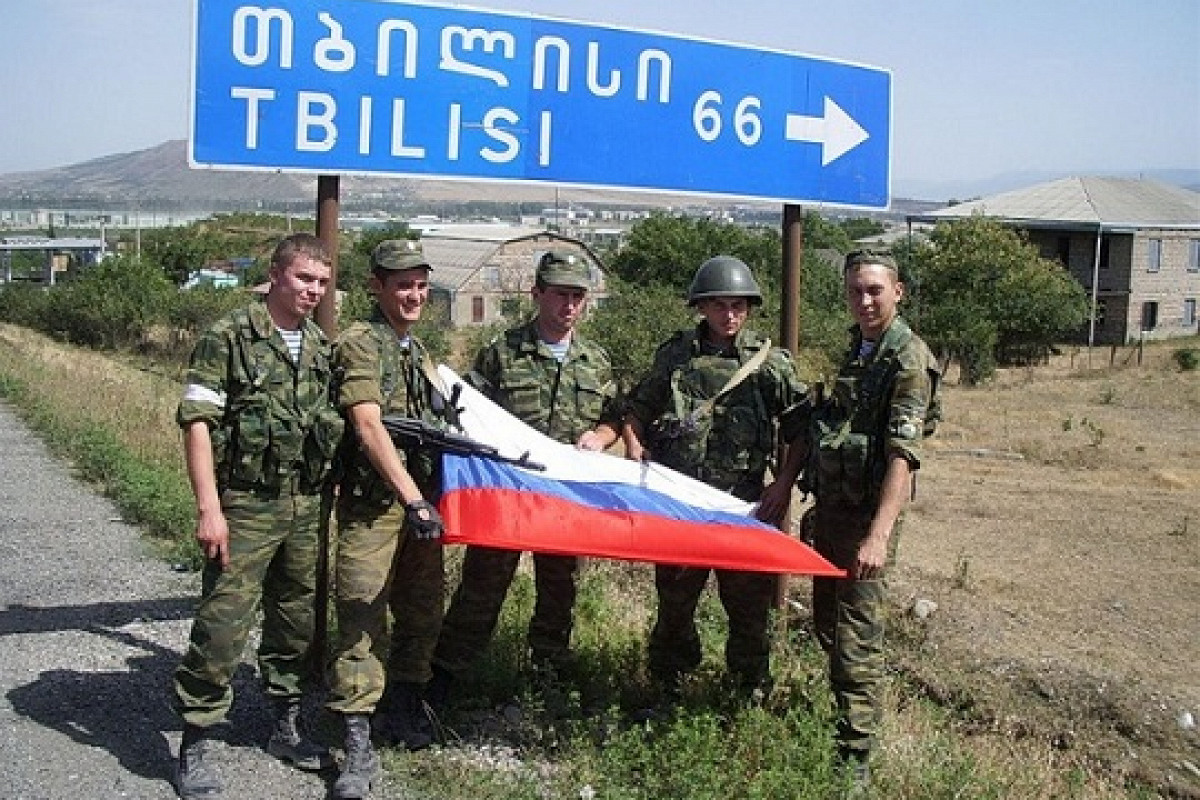In the war-torn Donbas region in the east of Ukraine, two disengagement zones have already been established in Luhansk Oblast and one more is about to emerge south of Donetsk.
Ukrainian President Volodymyr Zelenskyy sees the disengagement of troops and hardware along the entire Donbas frontline as a way to stop casualties. The logic behind his intention is simple: if the buffer zone is expanded far enough, there will be no physical possibility for targeted fire and the troops won't get engaged in everyday fighting anymore.
It is not the first disengagement attempt in the Russo-Ukrainian war: heavy weapons have been pulled out a few times throughout the war and the disengagement of troops occurred in three security zones in fall 2016. These attempts failed quite soon.
Russia has already participated in several disengagements in its other post-Soviet wars as a mediating, peacekeeping, or belligerent party.
Were the Russia-brokered disengagements of forces in Moldova and Georgia similar to Ukraine's and what were their consequences?

The disengagements of troops in Moldova and Georgia took place under interstate agreements on a ceasefire signed between heads of Russia and the conflict's "host state." Most of the treaties were de-facto capitulation pacts signed after a military defeat or a sharp escalation of hostilities. Such agreements, one way or another, enshrined the Russian military presence in an occupied region as a peacekeeping force and/or military monitoring mission and/or part of a ceasefire control group without any end terms of the mission defined.
The Donbas region's situation in Ukraine developed under a similar scenario in 2014 and early 2015. However, this time two Russia-Ukraine deals - the 2014 Minsk Protocol and the subsequent Package of Measures to implement the previous agreement - were not Russia's boilerplate capitulation agreements but included paragraphs impossible for Russia to fulfill. Moreover, both times the Russian-hybrid forces didn't cease hostilities while Ukraine didn't stop resisting.
1992 disengagement in Moldova's Transnistria

The conflict in the then- Moldovan Soviet Socialist Republic (SSR) brewed in the late Soviet times and developed shortly after the USSR's dissolution. The predominantly Russian-speaking industrial region to the east of Dnister River, Transnistria, proclaimed its independence from Moldova in 1990 fearing what they called Moldovan nationalism. Then-Soviet President, Mikhail Gorbachev voided these decisions by local councilors.
The tensions culminated in the Transnistrian War in March-July 1992. The Russian 14th Army, stationed at the moment in the region, supplied the anti-Moldovan rebels with weapons and equipment, mercenaries and volunteers from both Russia and Ukraine fought in the pro-Russian side, finally the 14th Army openly came down on the side of the rebels, obliterated the major Moldovan troops, and effectively forced Moldova into capitulation.
The peace treaty was signed on 21 July 1992 in Moscow by then-presidents of Russia and Moldova, Boris Yeltsin and Mircea Snegur. Its very first paragraph imposed a ceasefire, the second established a disengagement "safety zone," from which the "conflicting sides" should have pulled out their troops and hardware in seven days. The agreement also legalized the stay of Russia's 14th Army in the country and envisaged a joint trilateral Control Commission to monitor the ceasefire and peacekeeping contingents of Moldova, Transnistria, and Russia.
In 2017, Moldova's Constitutional Court concluded that the presence of Russian troops in Transnistria was unconstitutional and violated the law. However, Russia just ignored the ruling and had no intention to withdraw its contingent, while Moldova didn't take any further action.
The conflict in another Moldovan pro-Russian breakaway region, Gagauzia, never escalated into armed clashes. The region was successfully reintegrated as an autonomy, however, it still remains one of the tools for Russian leverage in Moldova.
Read more on Transnistria developments:
- Russian troops unconstitutionally occupy Moldovan territory – Constitutional Court
- Transnistria frozen conflict zone recognizes Russian tricolor as second “national” flag
- Why Ukraine must avoid the Transnistrian scenario
- Bulgaria, Moldova elect pro-Russian presidents
Mid-1990s and 2008 disengagements in Georgia
In 1990-1992, three autonomous regions of Georgia proclaimed independence. These were South Ossetia, Abkhazia, and Adjara. The populations of the first two regions bordering on Russia had an ethnic majority different from the titular ethnicity while most of the inhabitants of the third region were a subethnic group of Georgians.
Unlike Abkhazia and South Ossetia, the Adjara region doesn't border on Russia. and it so happened that the Adjaran separatist movement didn't result in armed clashes in the 1990s, the region just remained in limbo until the early 2000s when the pro-Russian local separatist government was overthrown and Adjara was reintegrated in Georgia as an autonomy.
1992 South Ossetia
The fighting erupted in South Ossetia as Georgia abolished the region's autonomy of the self-proclaimed "state" and tried to regain its control of South Ossetia by force. However, the Georgian attempts failed as the secessionists were supported by Russia. The March 1992 coup d'état ousted Georgian President Zviad Gamsakhurdia, and the new leader, former Soviet Foreign Minister Eduard Shevardnadze, signed the Sochi Agreement on a ceasefire in South Ossetia on 14 July 1992 amid an unfolding separatist rebellion in another Georgian region, Abkhazia.
As in the case of the agreement on Transnistria signed in the next month of the same year, the first paragraph of the agreement on South Ossetia imposed a ceasefire
, the second was about the disengagement of troops to create a "corridor adjacent to the line of juxtaposition." Thus, the agreement effectively outlined the borders of the South Ossetian territory. The agreement established a joint control commission and a joint peacekeeping body both composed of "representatives of opposing parties." The latter was put under Russian command and comprised of peacekeeping contingents from Georgia, Russia, and from the Russian region of North Ossetia.
The Sochi agreement left Georgia's South Ossetia divided into Georgia-controlled enclaves and areas controlled by the unrecognized government of South Ossetia.
The agreement effectively froze the conflict until 2004, when sporadic tensions started as Georgia resumed its efforts to return the breakaway region after the successful reintegration of Adjara.
1994 pull-out from Abkhazia
In June 1992 Abkhaz separatists attacked government buildings in the local capital, Sukhumi, and proclaimed independence on 23 July 1992. In August Georgian forces started an operation to regain control of the breakaway region and disarm separatist militias which included locals as well as various groups of Russian volunteer paramilitaries such as Chechens and Cossacks.

By September 1992, the Georgian army controlled most of Abkhazia with only several rebel-controlled pockets remaining. But on 3 September 1992, a ceasefire was negotiated in Russia by the leaders of Georgia, Russia, and Abkhazia. Georgian forces were obliged to pull out from the Gagra district adjacent to Russia. They retreated from their positions leaving the local Georgians defenseless. The separatists soon violated the truce and captured the city of Gagra supported by Russia's militias. Russia equipped the Abkhaz forces with various heavy equipment such as T-72 tanks, BM-21 multiple-rocket launcher systems, and even attack jets and helicopters. Meanwhile, the Russian Navy blockaded the sea in the area of Gagra to prevent a Georgian attack from the sea and secure the Russian supplies for the rebels.
In the process of the occupation of Abkhazia, several more ceasefires were negotiated, but they appeared to be nothing but buying time for preparing further Russian-Abkhaz offensive operations. By the end of 1993, Georgia lost almost the entire region including the regional capital Sukhumi.

In December 1993, the leaders of Georgia and Abkhazia with Russia as an intermediary signed a ceasefire under the aegis of the UN in Geneva. The further declaration on the political settlement of the conflict was signed in Moscow in April 1994, and the presence of Russian peacekeeping forces was agreed in the final Agreement on a Ceasefire and Separation of Forces signed in the same Moscow in May 1994.
The final 1994 agreement centered on the disengagement of forces along the Inguri river by creating a twelve-kilometer-wide "security zone." The Georgian forces were to withdraw and Russian peacekeeping troops were deployed in the area. It formed a border between Abkhazia and the rest of Georgia. The situation stabilized and the conflict was frozen until 2008.

2008 Russo-Georgian war
As a reply to Georgia's NATO aspirations, the Kremlin, which sees former Soviet republics in the Russian sphere of influence, dared to engage in open military aggression against an independent state for the first time in post-Soviet history.
In the spring of 2008, tensions started escalating in South Ossetia as the local forces started attacks on Georgian peacekeepers who were still stationed in the region, other Georgian troops in the area, and on Georgian villages.
In early August, the Ossetian forces intensified attacks to provoke the Georgian troops to engage in military actions, and the fighting culminated in a mortar and artillery fire exchange along the entire front line on 6 August.
On 7 August 2008, then-Georgian President Mikheil Saakashvili announced a unilateral ceasefire and no-response order. However, the Ossetian forces only intensified their attacks. As a result, Georgian forces resumed returning fire and advanced towards Tskhinvali, the capital city of the breakaway region.
Russia used the Georgian offensive as a pretext for its own full-scale invasion, accusing
Georgia of aggression against South Ossetia. The Russian troops were prepared for the invasion in advance at the Caucasus-2008 drills in July and remained deployed in the area near the Georgian border where the drill took place - from the Russian side of the mountain ridge, which separates Georgia from Russia. The full-scale Russian offensive started on 8 August 2008, later another one was launched from Russia-occupied Abkhazia.
Russia claimed that most of the South-Ossetians were Russian citizens and called its invasion of Georgia the “pacification by force” to “protect the Russian citizens.”
The war lasted only a few days and resulted in the capitulation of Georgia. On 10 August, Georgia announced a unilateral cessation of fire aiming to pull out its troops from South Ossetia, but Russia ignored the offer and continued pushing forward even after then French President Nicolas Sarkozy negotiated the agreement on 12 August with a ceasefire deadline set for the same day. On 15 August Saakashvili signed the peace plan, which included the withdrawal of Georgian troops to their permanent bases and the return of Russian troops to "the lines prior to the start of hostilities." Then-Russian President Dmitry Medvedev signed the document on the next day in Moscow.
On 26 August 2008, Russia recognized Abkhazia and South Ossetia as independent states. Most of the Russian troops were withdrawn from free Georgia back to its Russian-controlled enclaves by the end of September; however, some detachments stayed until December.
In early 2010, Georgia endorsed the “State Strategy on Occupied Territories: Engagement Through Cooperation,” which intended to "promote interaction among the divided populations of Georgia, currently separated by occupation lines and to ensure that residents of Abkhazia and the Tskhinvali region/South Ossetia enjoy the rights and privileges available to every citizen of Georgia.'
In 2016, then deputy economy minister of Georgia, Ketevan Bochorishvili, explained this Georgian strategy of the peaceful return of the breakaway regions, saying,
“The Georgian government has pledged that we will not get involved in an armed conflict. There is no way we’ll win. What we are looking for is to develop economically so that the people living in the occupied territories will want to go back to Georgia.”
Of course, this strategy of peaceful reintegration failed to come to any fruition in nine years of its implementation, since it doesn't take into account the full Russian control of the territories and its impact on the local populations.
What is more, Russia keeps expanding the occupation zones, covertly moving the borders
on a regular basis further into Georgia. Local Georgian media dubbed the Russian tactic as "the creeping border" or "the creeping occupation."
Russia got away with its invasion of Georgia and the impunity spiraled into the Russian invasions of Ukraine's Crimea and the Donbas in 2014.
Read more on Russo-Georgian conflicts:
- The Russian war against Georgia is far from over
- Georgia slams “elections” in occupied Abkhazia as legitimizing Russian aggression (2017)
- Ten years after: why Georgia failed to reintegrate its occupied territories (2018)
- Military photos from the Abkhaz-Georgian ceasefire in 1993
Disengagements in Ukraine's Donbas
Just like in September 1994 Abkhazia, the Russian-hybrid forces in the Donbas seemed doomed in the summer of 2014 after Ukrainian troops took control of most of the uncontrolled stretch of the border with Russia and nearly finished encircling two regional capitals, Luhansk and Donetsk.
However, Russia unleashed transborder artillery and rocket attacks on Ukrainian troops and later mass deployed its regular troops, recapturing most of the territory that Ukraine had managed to liberate during the military campaign. Heavy casualties among the trapped Ukrainian troops in the Battle of Ilovaisk forced Ukraine to negotiate a ceasefire.
The Minsk Protocol or Minsk-1 was signed in September 2014 by representatives of Russia, Ukraine, and the OSCE in the Trilateral Contact Group (TCG) for the resolution of the conflict in the east of Ukraine.
Unlike most of the other post-Soviet ceasefire agreements with Russia, it wasn't signed by the leaders of Russia and the "conflict-hosting" state, but rather by former Ukrainian president Leonid Kuchma, who wasn't even a state employee at the moment, and by then-Russian Ambassador to Ukraine Mikhail Zurabov. Later, signatures of leaders of Russia's puppet "people's republics" of Luhansk and Donetsk were added. Although it wasn't an official agreement, Ukrainian officials claimed their commitment to fulfill the deal.
The document didn't demand the total disengagement of troops along the front line, however, one of its paragraphs required
"To withdraw illegal armed groups and military equipment as well as fighters and mercenaries from the territory of Ukraine."
The follow-up memorandum established a 30-kilometer buffer zone for heavy weaponry along the front.
The ceasefire decreased hostilities but wasn't ever fully observed. Later the Russian-hybrid forces started the Battle for Donetsk Airport and in early 2015 the ceasefire completely collapsed as the battle for the Ukraine-controlled rail hub city of Debaltseve began. Once again, regular formations of the Russian army were involved in the battles alongside the locally-formed paramilitary groups comprised of local residents and Russian mercenaries.

The Russia-orchestrated escalation in the Donbas brought to negotiating of the "package of measures" meant to stop fighting, or Minsk-2. The deal, even less favorable for Ukraine than Minsk-1, was developed at the 11 February 2015 summit in Minsk by the leaders of Ukraine, Russia, France, and Germany. However, the signatories were the same as before.
Read the comparison of "Minsks": Minsk-2 is the real problem for Ukraine, not “Steinmeier’s formula” | Infographics
Like the Minsk-1, Minsk-2 didn't envisage the disengagement of infantry but demanded the pullout of foreign armed formations and mercenaries from the Ukrainian territory, and the pullout of artillery and rocket systems at the distances beyond operative ranges of particular types of hardware. Disregarding the new accords, the Russian-hybrid forces continued a heavy assault on Debaltseve and the Ukrainian troops were forced to retreat from the city on 18 February 2015.
Under Minsk-2, Ukrainian forces had to leave several settlements including the village of Pikuzy (Kominternove) that they liberated on 10 February 2015. On 22 December 2015, the Russian-hybrid formations took control of the defenseless village. Meanwhile, Debaltseve and nearby settlements occupied after Minsk-2 was signed were never returned under Ukrainian control.
Shortly after the Debaltseve Battle, the situation at the front mostly stabilized. However, from time to time the fighting escalated and new truces were negotiated over and over again by the TCG.

In September 2016, the TCG agreed on three disengagement zones in the areas of the towns of Stanytsia Luhanska and Zolote in Luhansk Oblast, and Petrivske in Donetsk Oblast. Ukraine pulled out its troops, however, soldiers returned to their positions several days later due to escalation in all areas.
Recently, Ukrainian President Volodymyr Zelenskyy resumed to the 2016 idea of the three disengagements and now has completed the pullouts in the areas of Stanytsia Luhanska and Zolote. The disengagement in Petrivske is about to occur too. The President's further plans include a total disengagement along the entire front-line. A number of Ukrainian settlements risk to find themselves in the demilitarized "gray zone."

Russia saw both Minsk deals with Ukraine as a kind of capitulation acts like the ones signed with Georgia and Moldova before, meaning to strengthen the Russian positions in the region and country. However, the Transnistrian, Abkhazian, and South Ossetian agreements staked on the legalization of the Russian military presence in the regions, while the Minsks, instead, meant to legalize the Russian-run statelets themselves as autonomies within Ukraine.
The disengagements as a final chord of the capitulation deals solidified the borders of the occupied regions and established a Russian border control. Disengagements of any other kind don't guarantee the safety of the demilitarized zone as it happened in Georgia's Gagra district in Abkhazia, which was occupied in 1992 shortly after Georgia pulled out its troops under the ceasefire agreement with Russia.
Further reading:
- North Caucasus expert: Moscow’s actions in Abkhazia and Chechnya justify fears about ‘Steinmeier formula’
- Piontkovsky: Frozen conflict in Donbas – ‘lesser evil’ for both Kyiv and ‘moderate imperialists’ in Moscow
- Ten years after the Russian-Georgian war: the Kremlin’s unlearned lessons
- Traps of the Transnistrian conflict
- Everything you wanted to know about the Minsk peace deal, but were afraid to ask
- Occupied Donbas risks becoming like South Ossetia (2017)
- Putin suddenly wants armed peacekeepers in Donbas. Why now? What for? (2017)
- North Caucasus republics could flourish on their own, Israeli political analyst says
- Ukraine helps Moldova regain control over border in Transnistrian region
- Georgia’s lessons of peacebuilding now instructive for Ukrainians
- Transnistria. Why Russia should leave the occupied territories
- Russian provocations test Georgia
- Stages of Russian occupation in a nutshell
- Is Russia’s passport scheme in Donbas a harbinger of full-scale invasion like in 2008 Georgia?
- Policy shift shows Russia preparing to recognize its puppet republics in Donbas
- Why Russia does not want peace in the Donbas
- Moscow to start distributing Russian passports in the occupied Donbas
- The Kremlin’s five steps towards recognizing “DNR/LNR”
- Putin’s ‘hybrid’ recognition of Moscow-sponsored breakaway republics in Ukraine
- Russia’s creeping annexation of Georgian territory
- Top 10 Russian lies about the Georgia war
- Russia determined to expand influence over former Soviet colonies
- Putin’s ‘hybrid’ recognition of Moscow-sponsored breakaway republics in Ukraine
- Military photos from the Abkhaz-Georgian ceasefire in 1993
- Major Hostile Actions by the Russian Federation against Georgia in 2004-2007
- Ten years after: why Georgia failed to reintegrate its occupied territories
- Georgian diplomat: If West allows Russia a role in Donbas, Moscow will destabilize Ukraine for decades (2015)
- How the Russo-Georgian War of 2008 Started
- Gagauzia – object lesson for Ukraine on how a ‘reintegrated’ region gives Moscow leverage
- Is Russia’s passport scheme in Donbas a harbinger of full-scale invasion like in 2008 Georgia?

